Information System for Stakeholders of the G-Train
VerifiedAdded on 2022/10/12
|10
|4150
|332
AI Summary
This report provides an analysis of the present issue that is being faced in the G – train of the QLD rail and provides an appropriate solution for the issue. It also recommends a new ticket booking system and transaction processing system for allowing the personalized ticket booking experience for the customers of the organization.
Contribute Materials
Your contribution can guide someone’s learning journey. Share your
documents today.
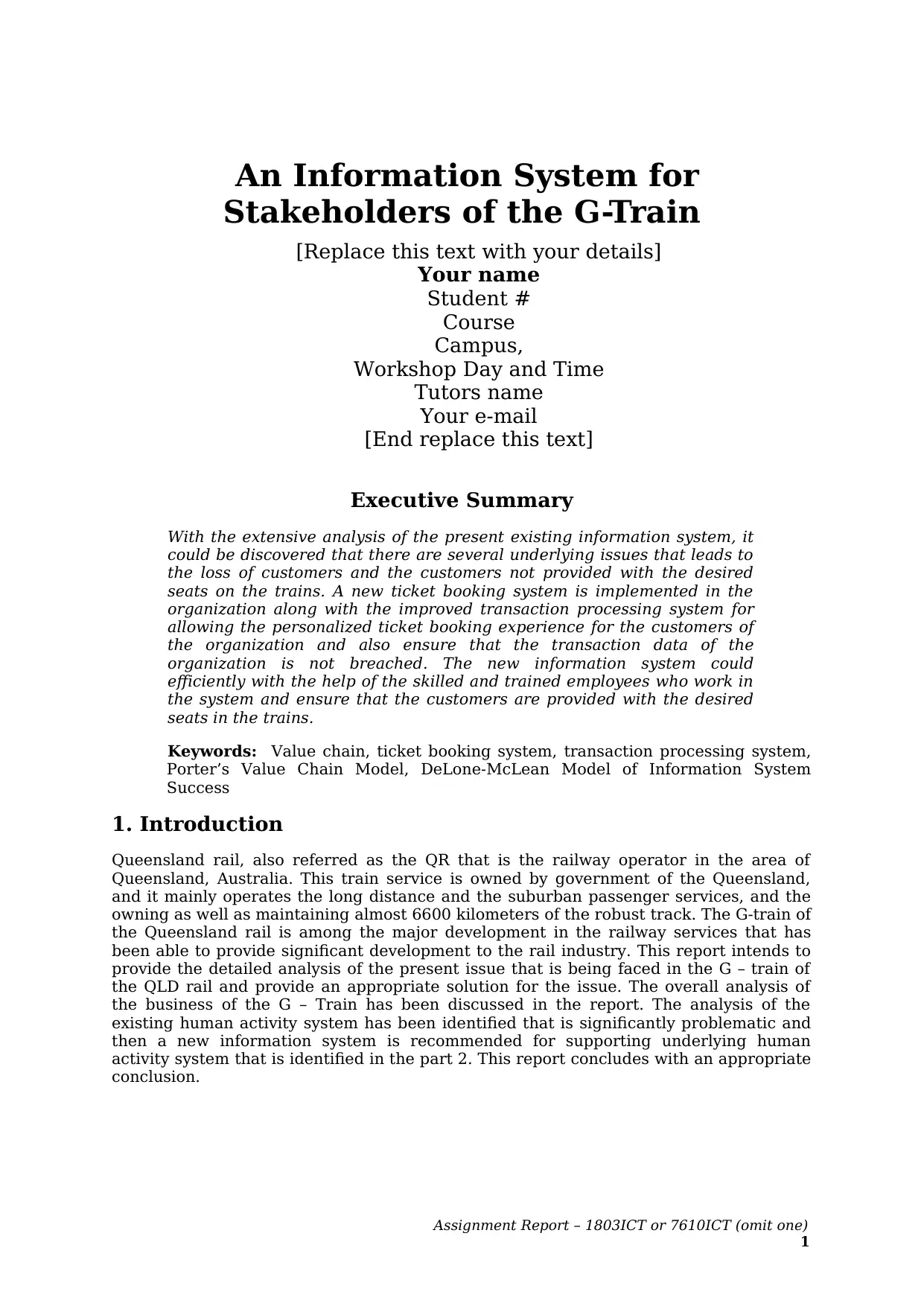
An Information System for
Stakeholders of the G-Train
[Replace this text with your details]
Your name
Student #
Course
Campus,
Workshop Day and Time
Tutors name
Your e-mail
[End replace this text]
Executive Summary
With the extensive analysis of the present existing information system, it
could be discovered that there are several underlying issues that leads to
the loss of customers and the customers not provided with the desired
seats on the trains. A new ticket booking system is implemented in the
organization along with the improved transaction processing system for
allowing the personalized ticket booking experience for the customers of
the organization and also ensure that the transaction data of the
organization is not breached. The new information system could
efficiently with the help of the skilled and trained employees who work in
the system and ensure that the customers are provided with the desired
seats in the trains.
Keywords: Value chain, ticket booking system, transaction processing system,
Porter’s Value Chain Model, DeLone-McLean Model of Information System
Success
1. Introduction
Queensland rail, also referred as the QR that is the railway operator in the area of
Queensland, Australia. This train service is owned by government of the Queensland,
and it mainly operates the long distance and the suburban passenger services, and the
owning as well as maintaining almost 6600 kilometers of the robust track. The G-train of
the Queensland rail is among the major development in the railway services that has
been able to provide significant development to the rail industry. This report intends to
provide the detailed analysis of the present issue that is being faced in the G – train of
the QLD rail and provide an appropriate solution for the issue. The overall analysis of
the business of the G – Train has been discussed in the report. The analysis of the
existing human activity system has been identified that is significantly problematic and
then a new information system is recommended for supporting underlying human
activity system that is identified in the part 2. This report concludes with an appropriate
conclusion.
Assignment Report – 1803ICT or 7610ICT (omit one)
1
Stakeholders of the G-Train
[Replace this text with your details]
Your name
Student #
Course
Campus,
Workshop Day and Time
Tutors name
Your e-mail
[End replace this text]
Executive Summary
With the extensive analysis of the present existing information system, it
could be discovered that there are several underlying issues that leads to
the loss of customers and the customers not provided with the desired
seats on the trains. A new ticket booking system is implemented in the
organization along with the improved transaction processing system for
allowing the personalized ticket booking experience for the customers of
the organization and also ensure that the transaction data of the
organization is not breached. The new information system could
efficiently with the help of the skilled and trained employees who work in
the system and ensure that the customers are provided with the desired
seats in the trains.
Keywords: Value chain, ticket booking system, transaction processing system,
Porter’s Value Chain Model, DeLone-McLean Model of Information System
Success
1. Introduction
Queensland rail, also referred as the QR that is the railway operator in the area of
Queensland, Australia. This train service is owned by government of the Queensland,
and it mainly operates the long distance and the suburban passenger services, and the
owning as well as maintaining almost 6600 kilometers of the robust track. The G-train of
the Queensland rail is among the major development in the railway services that has
been able to provide significant development to the rail industry. This report intends to
provide the detailed analysis of the present issue that is being faced in the G – train of
the QLD rail and provide an appropriate solution for the issue. The overall analysis of
the business of the G – Train has been discussed in the report. The analysis of the
existing human activity system has been identified that is significantly problematic and
then a new information system is recommended for supporting underlying human
activity system that is identified in the part 2. This report concludes with an appropriate
conclusion.
Assignment Report – 1803ICT or 7610ICT (omit one)
1
Secure Best Marks with AI Grader
Need help grading? Try our AI Grader for instant feedback on your assignments.
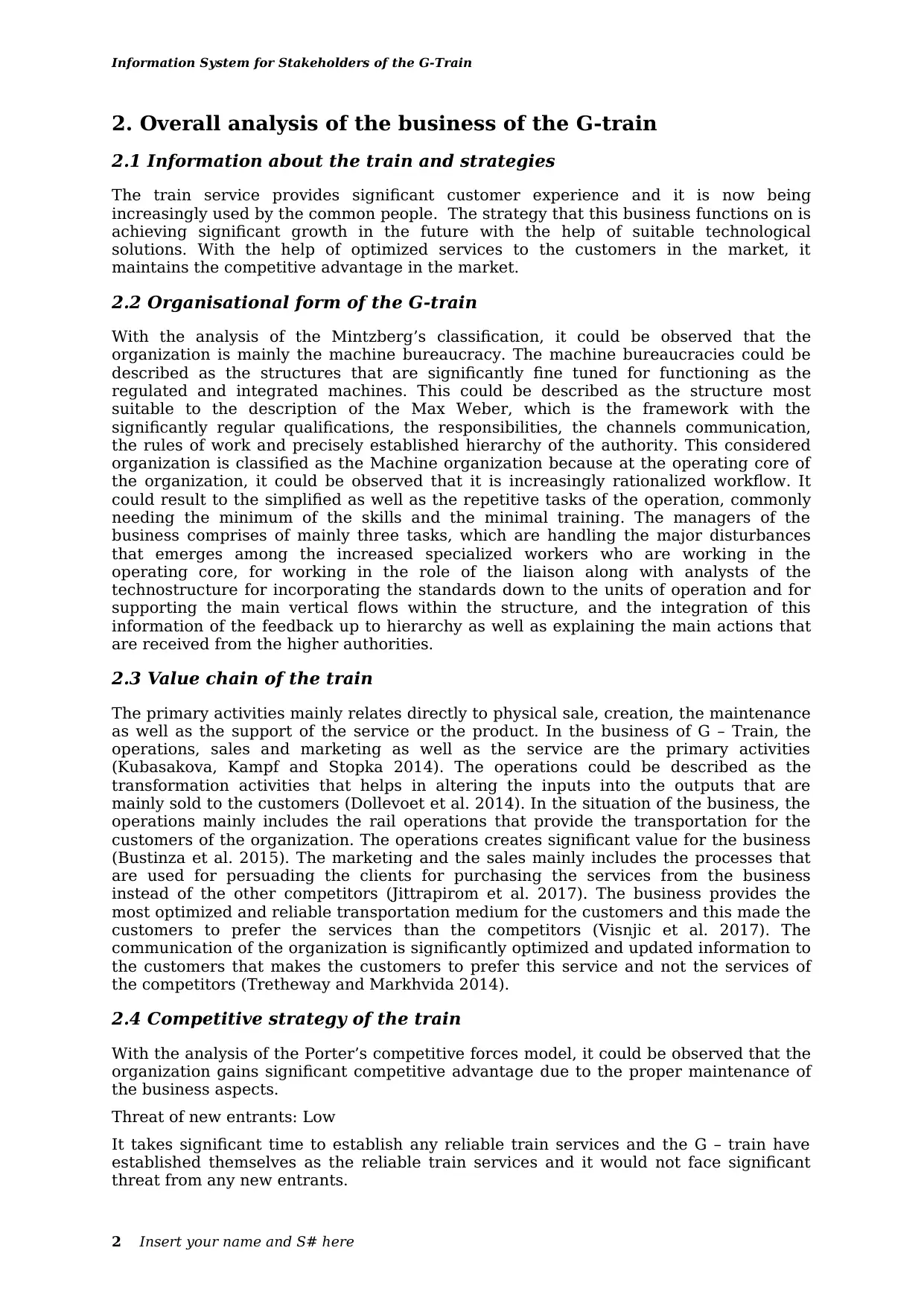
Information System for Stakeholders of the G-Train
2. Overall analysis of the business of the G-train
2.1 Information about the train and strategies
The train service provides significant customer experience and it is now being
increasingly used by the common people. The strategy that this business functions on is
achieving significant growth in the future with the help of suitable technological
solutions. With the help of optimized services to the customers in the market, it
maintains the competitive advantage in the market.
2.2 Organisational form of the G-train
With the analysis of the Mintzberg’s classification, it could be observed that the
organization is mainly the machine bureaucracy. The machine bureaucracies could be
described as the structures that are significantly fine tuned for functioning as the
regulated and integrated machines. This could be described as the structure most
suitable to the description of the Max Weber, which is the framework with the
significantly regular qualifications, the responsibilities, the channels communication,
the rules of work and precisely established hierarchy of the authority. This considered
organization is classified as the Machine organization because at the operating core of
the organization, it could be observed that it is increasingly rationalized workflow. It
could result to the simplified as well as the repetitive tasks of the operation, commonly
needing the minimum of the skills and the minimal training. The managers of the
business comprises of mainly three tasks, which are handling the major disturbances
that emerges among the increased specialized workers who are working in the
operating core, for working in the role of the liaison along with analysts of the
technostructure for incorporating the standards down to the units of operation and for
supporting the main vertical flows within the structure, and the integration of this
information of the feedback up to hierarchy as well as explaining the main actions that
are received from the higher authorities.
2.3 Value chain of the train
The primary activities mainly relates directly to physical sale, creation, the maintenance
as well as the support of the service or the product. In the business of G – Train, the
operations, sales and marketing as well as the service are the primary activities
(Kubasakova, Kampf and Stopka 2014). The operations could be described as the
transformation activities that helps in altering the inputs into the outputs that are
mainly sold to the customers (Dollevoet et al. 2014). In the situation of the business, the
operations mainly includes the rail operations that provide the transportation for the
customers of the organization. The operations creates significant value for the business
(Bustinza et al. 2015). The marketing and the sales mainly includes the processes that
are used for persuading the clients for purchasing the services from the business
instead of the other competitors (Jittrapirom et al. 2017). The business provides the
most optimized and reliable transportation medium for the customers and this made the
customers to prefer the services than the competitors (Visnjic et al. 2017). The
communication of the organization is significantly optimized and updated information to
the customers that makes the customers to prefer this service and not the services of
the competitors (Tretheway and Markhvida 2014).
2.4 Competitive strategy of the train
With the analysis of the Porter’s competitive forces model, it could be observed that the
organization gains significant competitive advantage due to the proper maintenance of
the business aspects.
Threat of new entrants: Low
It takes significant time to establish any reliable train services and the G – train have
established themselves as the reliable train services and it would not face significant
threat from any new entrants.
2 Insert your name and S# here
2. Overall analysis of the business of the G-train
2.1 Information about the train and strategies
The train service provides significant customer experience and it is now being
increasingly used by the common people. The strategy that this business functions on is
achieving significant growth in the future with the help of suitable technological
solutions. With the help of optimized services to the customers in the market, it
maintains the competitive advantage in the market.
2.2 Organisational form of the G-train
With the analysis of the Mintzberg’s classification, it could be observed that the
organization is mainly the machine bureaucracy. The machine bureaucracies could be
described as the structures that are significantly fine tuned for functioning as the
regulated and integrated machines. This could be described as the structure most
suitable to the description of the Max Weber, which is the framework with the
significantly regular qualifications, the responsibilities, the channels communication,
the rules of work and precisely established hierarchy of the authority. This considered
organization is classified as the Machine organization because at the operating core of
the organization, it could be observed that it is increasingly rationalized workflow. It
could result to the simplified as well as the repetitive tasks of the operation, commonly
needing the minimum of the skills and the minimal training. The managers of the
business comprises of mainly three tasks, which are handling the major disturbances
that emerges among the increased specialized workers who are working in the
operating core, for working in the role of the liaison along with analysts of the
technostructure for incorporating the standards down to the units of operation and for
supporting the main vertical flows within the structure, and the integration of this
information of the feedback up to hierarchy as well as explaining the main actions that
are received from the higher authorities.
2.3 Value chain of the train
The primary activities mainly relates directly to physical sale, creation, the maintenance
as well as the support of the service or the product. In the business of G – Train, the
operations, sales and marketing as well as the service are the primary activities
(Kubasakova, Kampf and Stopka 2014). The operations could be described as the
transformation activities that helps in altering the inputs into the outputs that are
mainly sold to the customers (Dollevoet et al. 2014). In the situation of the business, the
operations mainly includes the rail operations that provide the transportation for the
customers of the organization. The operations creates significant value for the business
(Bustinza et al. 2015). The marketing and the sales mainly includes the processes that
are used for persuading the clients for purchasing the services from the business
instead of the other competitors (Jittrapirom et al. 2017). The business provides the
most optimized and reliable transportation medium for the customers and this made the
customers to prefer the services than the competitors (Visnjic et al. 2017). The
communication of the organization is significantly optimized and updated information to
the customers that makes the customers to prefer this service and not the services of
the competitors (Tretheway and Markhvida 2014).
2.4 Competitive strategy of the train
With the analysis of the Porter’s competitive forces model, it could be observed that the
organization gains significant competitive advantage due to the proper maintenance of
the business aspects.
Threat of new entrants: Low
It takes significant time to establish any reliable train services and the G – train have
established themselves as the reliable train services and it would not face significant
threat from any new entrants.
2 Insert your name and S# here
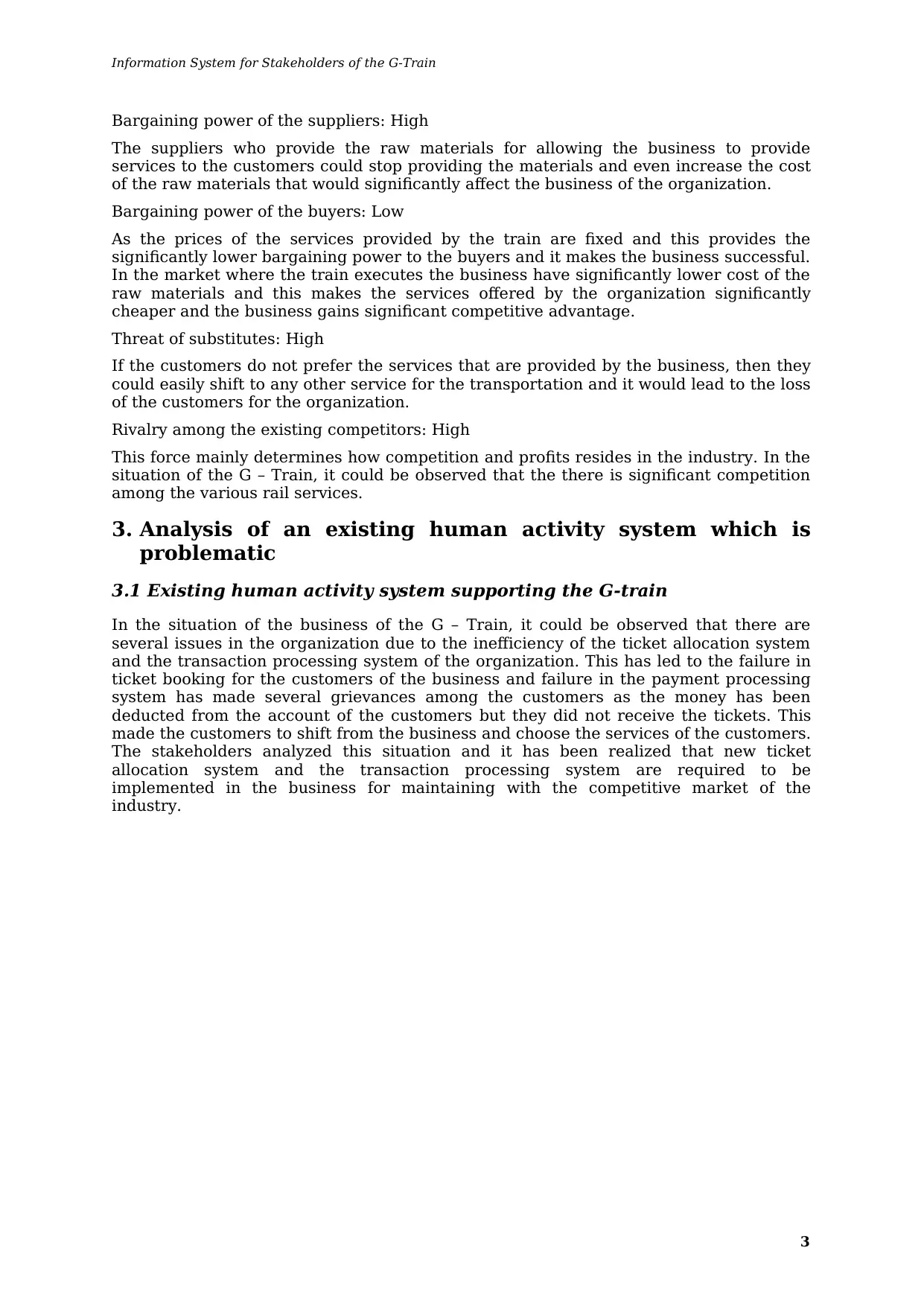
Information System for Stakeholders of the G-Train
Bargaining power of the suppliers: High
The suppliers who provide the raw materials for allowing the business to provide
services to the customers could stop providing the materials and even increase the cost
of the raw materials that would significantly affect the business of the organization.
Bargaining power of the buyers: Low
As the prices of the services provided by the train are fixed and this provides the
significantly lower bargaining power to the buyers and it makes the business successful.
In the market where the train executes the business have significantly lower cost of the
raw materials and this makes the services offered by the organization significantly
cheaper and the business gains significant competitive advantage.
Threat of substitutes: High
If the customers do not prefer the services that are provided by the business, then they
could easily shift to any other service for the transportation and it would lead to the loss
of the customers for the organization.
Rivalry among the existing competitors: High
This force mainly determines how competition and profits resides in the industry. In the
situation of the G – Train, it could be observed that the there is significant competition
among the various rail services.
3. Analysis of an existing human activity system which is
problematic
3.1 Existing human activity system supporting the G-train
In the situation of the business of the G – Train, it could be observed that there are
several issues in the organization due to the inefficiency of the ticket allocation system
and the transaction processing system of the organization. This has led to the failure in
ticket booking for the customers of the business and failure in the payment processing
system has made several grievances among the customers as the money has been
deducted from the account of the customers but they did not receive the tickets. This
made the customers to shift from the business and choose the services of the customers.
The stakeholders analyzed this situation and it has been realized that new ticket
allocation system and the transaction processing system are required to be
implemented in the business for maintaining with the competitive market of the
industry.
3
Bargaining power of the suppliers: High
The suppliers who provide the raw materials for allowing the business to provide
services to the customers could stop providing the materials and even increase the cost
of the raw materials that would significantly affect the business of the organization.
Bargaining power of the buyers: Low
As the prices of the services provided by the train are fixed and this provides the
significantly lower bargaining power to the buyers and it makes the business successful.
In the market where the train executes the business have significantly lower cost of the
raw materials and this makes the services offered by the organization significantly
cheaper and the business gains significant competitive advantage.
Threat of substitutes: High
If the customers do not prefer the services that are provided by the business, then they
could easily shift to any other service for the transportation and it would lead to the loss
of the customers for the organization.
Rivalry among the existing competitors: High
This force mainly determines how competition and profits resides in the industry. In the
situation of the G – Train, it could be observed that the there is significant competition
among the various rail services.
3. Analysis of an existing human activity system which is
problematic
3.1 Existing human activity system supporting the G-train
In the situation of the business of the G – Train, it could be observed that there are
several issues in the organization due to the inefficiency of the ticket allocation system
and the transaction processing system of the organization. This has led to the failure in
ticket booking for the customers of the business and failure in the payment processing
system has made several grievances among the customers as the money has been
deducted from the account of the customers but they did not receive the tickets. This
made the customers to shift from the business and choose the services of the customers.
The stakeholders analyzed this situation and it has been realized that new ticket
allocation system and the transaction processing system are required to be
implemented in the business for maintaining with the competitive market of the
industry.
3
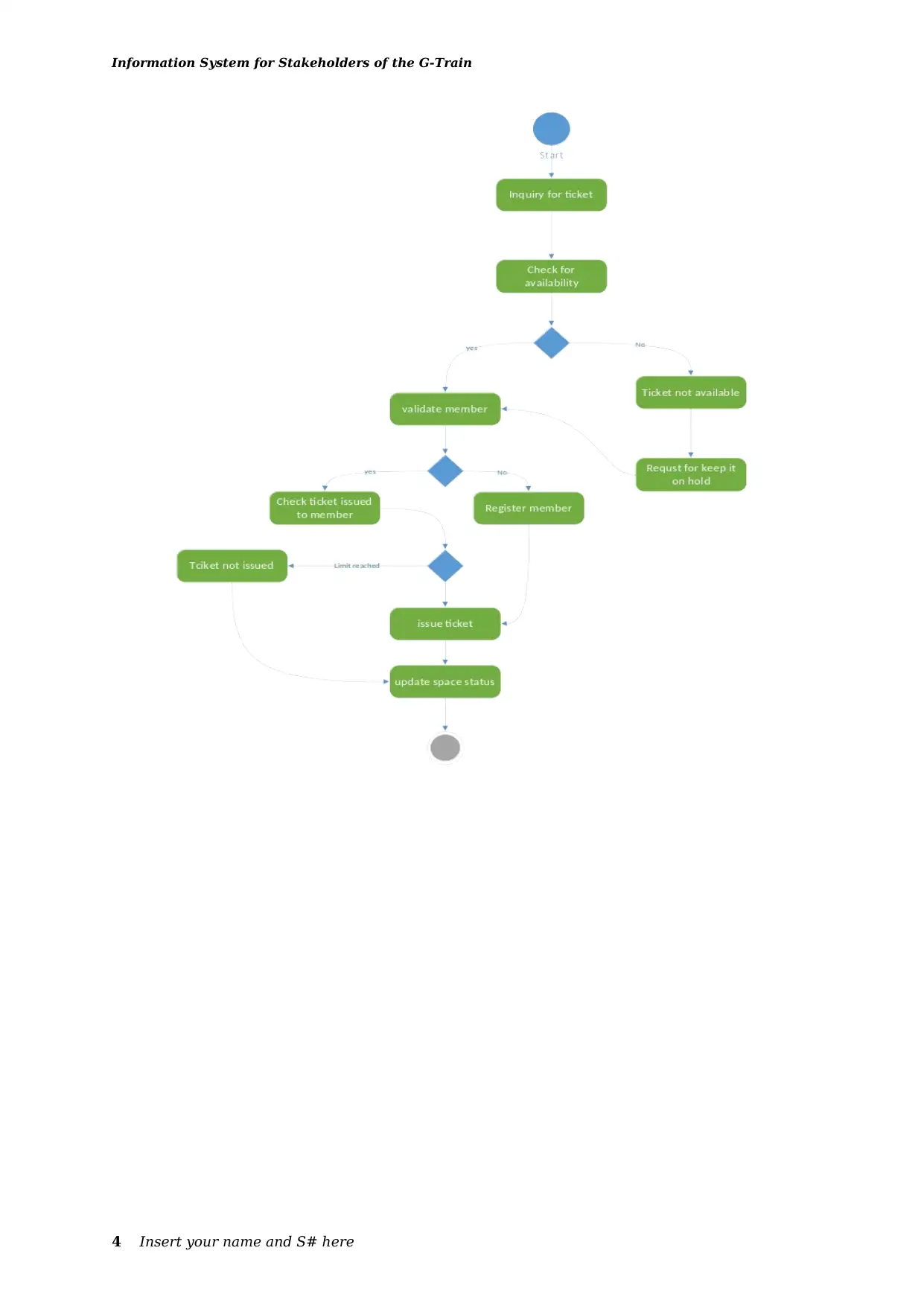
Information System for Stakeholders of the G-Train
4 Insert your name and S# here
4 Insert your name and S# here
Secure Best Marks with AI Grader
Need help grading? Try our AI Grader for instant feedback on your assignments.
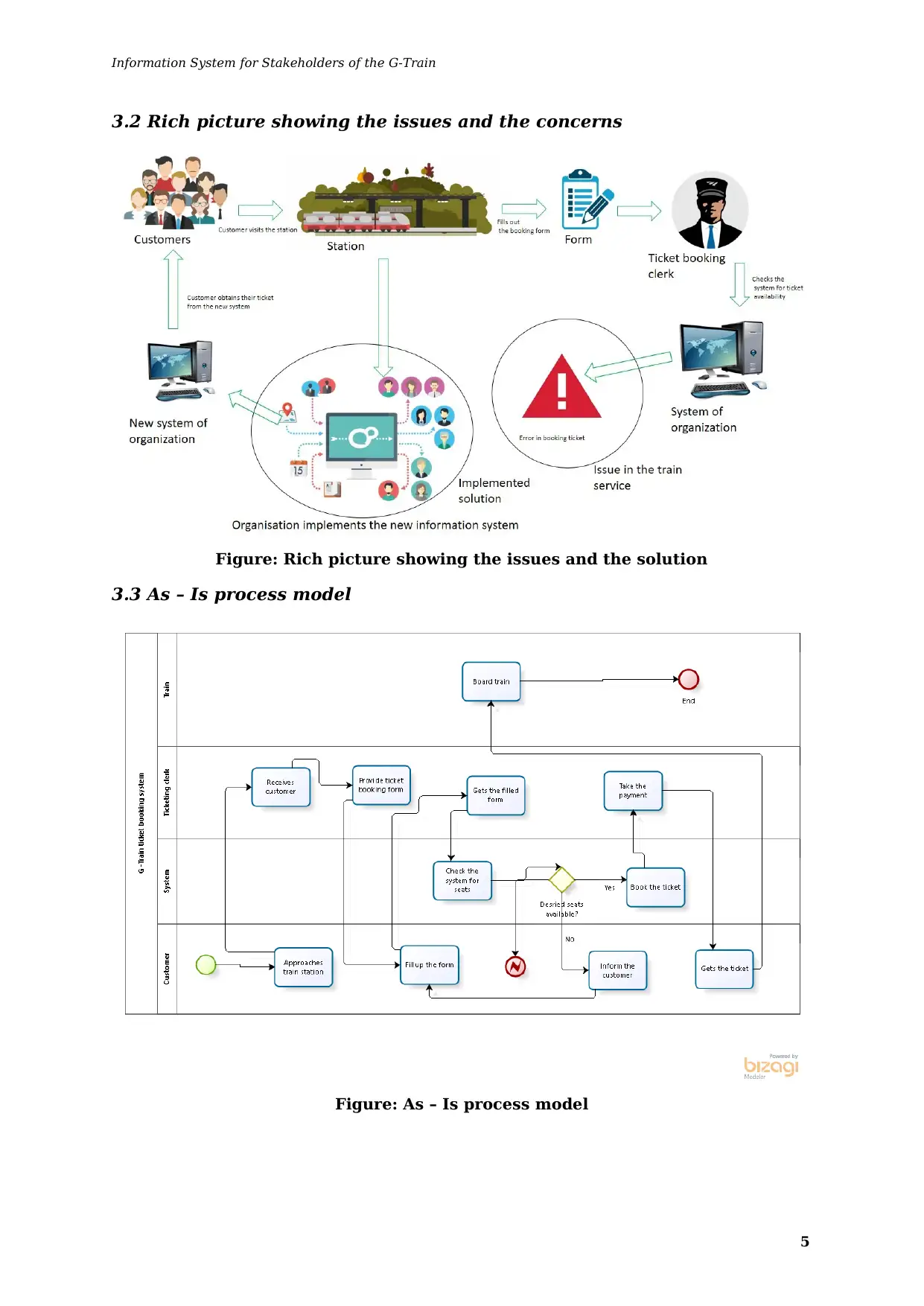
Information System for Stakeholders of the G-Train
3.2 Rich picture showing the issues and the concerns
Figure: Rich picture showing the issues and the solution
3.3 As – Is process model
Figure: As – Is process model
5
3.2 Rich picture showing the issues and the concerns
Figure: Rich picture showing the issues and the solution
3.3 As – Is process model
Figure: As – Is process model
5
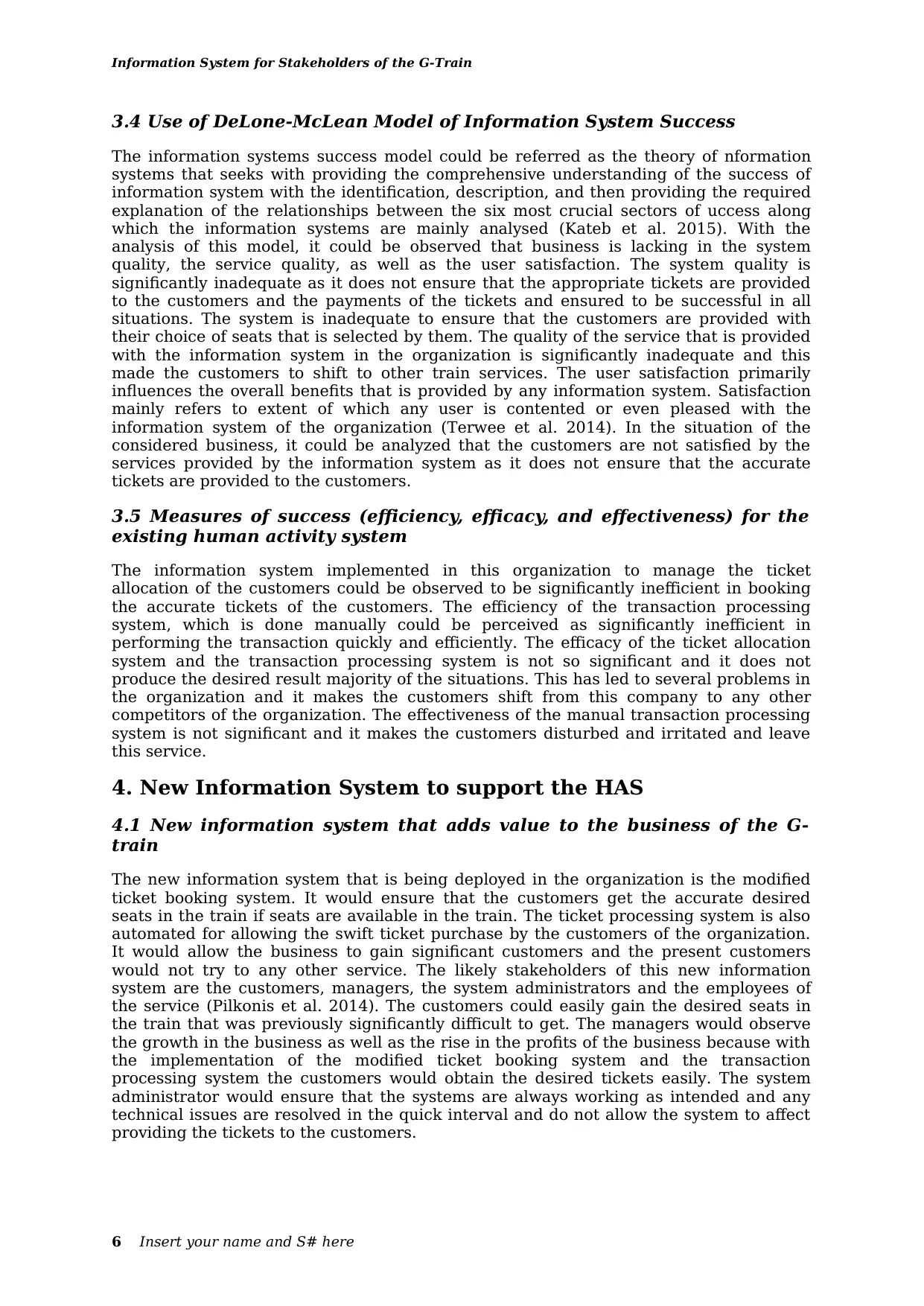
Information System for Stakeholders of the G-Train
3.4 Use of DeLone-McLean Model of Information System Success
The information systems success model could be referred as the theory of nformation
systems that seeks with providing the comprehensive understanding of the success of
information system with the identification, description, and then providing the required
explanation of the relationships between the six most crucial sectors of uccess along
which the information systems are mainly analysed (Kateb et al. 2015). With the
analysis of this model, it could be observed that business is lacking in the system
quality, the service quality, as well as the user satisfaction. The system quality is
significantly inadequate as it does not ensure that the appropriate tickets are provided
to the customers and the payments of the tickets and ensured to be successful in all
situations. The system is inadequate to ensure that the customers are provided with
their choice of seats that is selected by them. The quality of the service that is provided
with the information system in the organization is significantly inadequate and this
made the customers to shift to other train services. The user satisfaction primarily
influences the overall benefits that is provided by any information system. Satisfaction
mainly refers to extent of which any user is contented or even pleased with the
information system of the organization (Terwee et al. 2014). In the situation of the
considered business, it could be analyzed that the customers are not satisfied by the
services provided by the information system as it does not ensure that the accurate
tickets are provided to the customers.
3.5 Measures of success (efficiency, efficacy, and effectiveness) for the
existing human activity system
The information system implemented in this organization to manage the ticket
allocation of the customers could be observed to be significantly inefficient in booking
the accurate tickets of the customers. The efficiency of the transaction processing
system, which is done manually could be perceived as significantly inefficient in
performing the transaction quickly and efficiently. The efficacy of the ticket allocation
system and the transaction processing system is not so significant and it does not
produce the desired result majority of the situations. This has led to several problems in
the organization and it makes the customers shift from this company to any other
competitors of the organization. The effectiveness of the manual transaction processing
system is not significant and it makes the customers disturbed and irritated and leave
this service.
4. New Information System to support the HAS
4.1 New information system that adds value to the business of the G-
train
The new information system that is being deployed in the organization is the modified
ticket booking system. It would ensure that the customers get the accurate desired
seats in the train if seats are available in the train. The ticket processing system is also
automated for allowing the swift ticket purchase by the customers of the organization.
It would allow the business to gain significant customers and the present customers
would not try to any other service. The likely stakeholders of this new information
system are the customers, managers, the system administrators and the employees of
the service (Pilkonis et al. 2014). The customers could easily gain the desired seats in
the train that was previously significantly difficult to get. The managers would observe
the growth in the business as well as the rise in the profits of the business because with
the implementation of the modified ticket booking system and the transaction
processing system the customers would obtain the desired tickets easily. The system
administrator would ensure that the systems are always working as intended and any
technical issues are resolved in the quick interval and do not allow the system to affect
providing the tickets to the customers.
6 Insert your name and S# here
3.4 Use of DeLone-McLean Model of Information System Success
The information systems success model could be referred as the theory of nformation
systems that seeks with providing the comprehensive understanding of the success of
information system with the identification, description, and then providing the required
explanation of the relationships between the six most crucial sectors of uccess along
which the information systems are mainly analysed (Kateb et al. 2015). With the
analysis of this model, it could be observed that business is lacking in the system
quality, the service quality, as well as the user satisfaction. The system quality is
significantly inadequate as it does not ensure that the appropriate tickets are provided
to the customers and the payments of the tickets and ensured to be successful in all
situations. The system is inadequate to ensure that the customers are provided with
their choice of seats that is selected by them. The quality of the service that is provided
with the information system in the organization is significantly inadequate and this
made the customers to shift to other train services. The user satisfaction primarily
influences the overall benefits that is provided by any information system. Satisfaction
mainly refers to extent of which any user is contented or even pleased with the
information system of the organization (Terwee et al. 2014). In the situation of the
considered business, it could be analyzed that the customers are not satisfied by the
services provided by the information system as it does not ensure that the accurate
tickets are provided to the customers.
3.5 Measures of success (efficiency, efficacy, and effectiveness) for the
existing human activity system
The information system implemented in this organization to manage the ticket
allocation of the customers could be observed to be significantly inefficient in booking
the accurate tickets of the customers. The efficiency of the transaction processing
system, which is done manually could be perceived as significantly inefficient in
performing the transaction quickly and efficiently. The efficacy of the ticket allocation
system and the transaction processing system is not so significant and it does not
produce the desired result majority of the situations. This has led to several problems in
the organization and it makes the customers shift from this company to any other
competitors of the organization. The effectiveness of the manual transaction processing
system is not significant and it makes the customers disturbed and irritated and leave
this service.
4. New Information System to support the HAS
4.1 New information system that adds value to the business of the G-
train
The new information system that is being deployed in the organization is the modified
ticket booking system. It would ensure that the customers get the accurate desired
seats in the train if seats are available in the train. The ticket processing system is also
automated for allowing the swift ticket purchase by the customers of the organization.
It would allow the business to gain significant customers and the present customers
would not try to any other service. The likely stakeholders of this new information
system are the customers, managers, the system administrators and the employees of
the service (Pilkonis et al. 2014). The customers could easily gain the desired seats in
the train that was previously significantly difficult to get. The managers would observe
the growth in the business as well as the rise in the profits of the business because with
the implementation of the modified ticket booking system and the transaction
processing system the customers would obtain the desired tickets easily. The system
administrator would ensure that the systems are always working as intended and any
technical issues are resolved in the quick interval and do not allow the system to affect
providing the tickets to the customers.
6 Insert your name and S# here
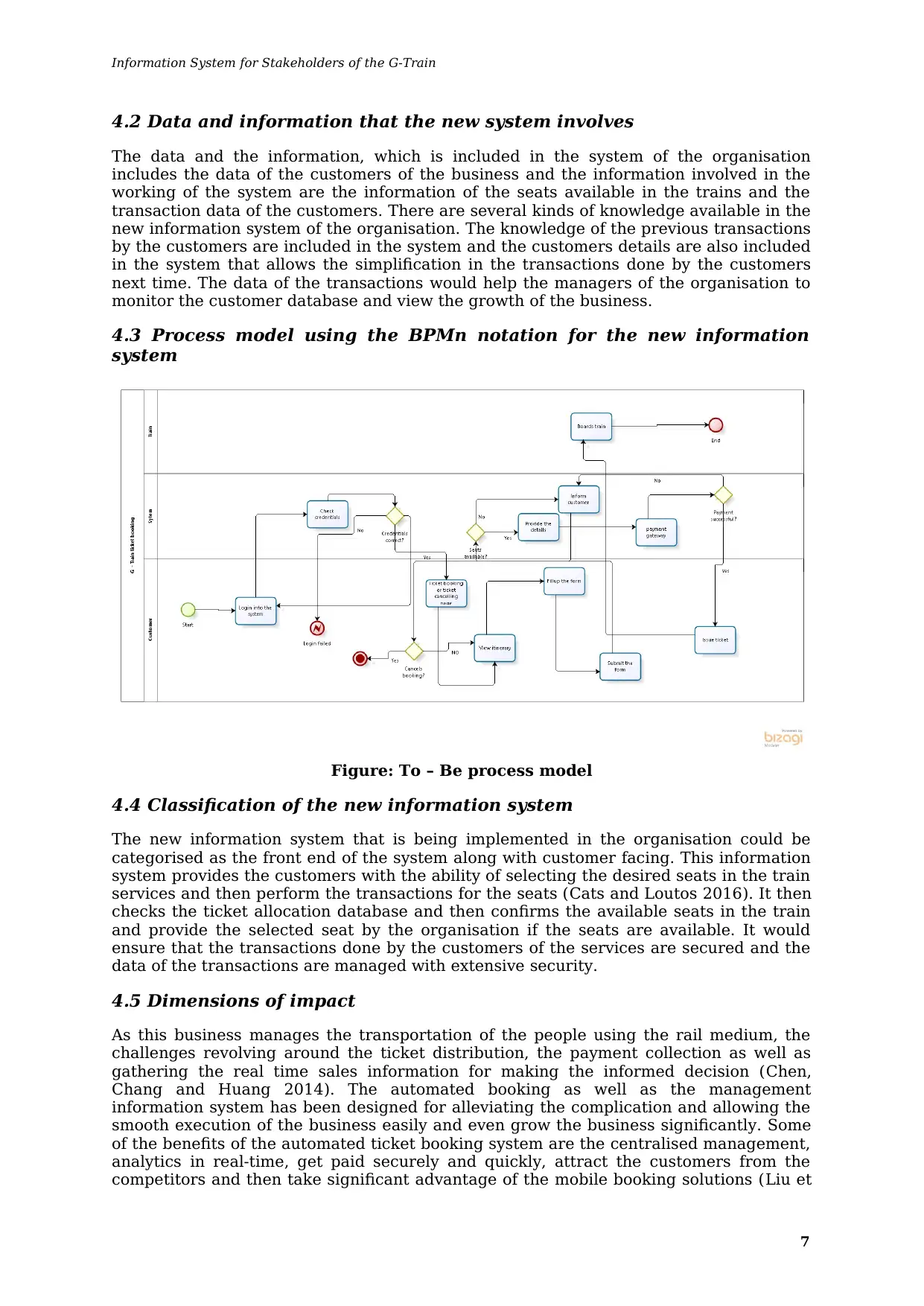
Information System for Stakeholders of the G-Train
4.2 Data and information that the new system involves
The data and the information, which is included in the system of the organisation
includes the data of the customers of the business and the information involved in the
working of the system are the information of the seats available in the trains and the
transaction data of the customers. There are several kinds of knowledge available in the
new information system of the organisation. The knowledge of the previous transactions
by the customers are included in the system and the customers details are also included
in the system that allows the simplification in the transactions done by the customers
next time. The data of the transactions would help the managers of the organisation to
monitor the customer database and view the growth of the business.
4.3 Process model using the BPMn notation for the new information
system
Figure: To – Be process model
4.4 Classification of the new information system
The new information system that is being implemented in the organisation could be
categorised as the front end of the system along with customer facing. This information
system provides the customers with the ability of selecting the desired seats in the train
services and then perform the transactions for the seats (Cats and Loutos 2016). It then
checks the ticket allocation database and then confirms the available seats in the train
and provide the selected seat by the organisation if the seats are available. It would
ensure that the transactions done by the customers of the services are secured and the
data of the transactions are managed with extensive security.
4.5 Dimensions of impact
As this business manages the transportation of the people using the rail medium, the
challenges revolving around the ticket distribution, the payment collection as well as
gathering the real time sales information for making the informed decision (Chen,
Chang and Huang 2014). The automated booking as well as the management
information system has been designed for alleviating the complication and allowing the
smooth execution of the business easily and even grow the business significantly. Some
of the benefits of the automated ticket booking system are the centralised management,
analytics in real-time, get paid securely and quickly, attract the customers from the
competitors and then take significant advantage of the mobile booking solutions (Liu et
7
4.2 Data and information that the new system involves
The data and the information, which is included in the system of the organisation
includes the data of the customers of the business and the information involved in the
working of the system are the information of the seats available in the trains and the
transaction data of the customers. There are several kinds of knowledge available in the
new information system of the organisation. The knowledge of the previous transactions
by the customers are included in the system and the customers details are also included
in the system that allows the simplification in the transactions done by the customers
next time. The data of the transactions would help the managers of the organisation to
monitor the customer database and view the growth of the business.
4.3 Process model using the BPMn notation for the new information
system
Figure: To – Be process model
4.4 Classification of the new information system
The new information system that is being implemented in the organisation could be
categorised as the front end of the system along with customer facing. This information
system provides the customers with the ability of selecting the desired seats in the train
services and then perform the transactions for the seats (Cats and Loutos 2016). It then
checks the ticket allocation database and then confirms the available seats in the train
and provide the selected seat by the organisation if the seats are available. It would
ensure that the transactions done by the customers of the services are secured and the
data of the transactions are managed with extensive security.
4.5 Dimensions of impact
As this business manages the transportation of the people using the rail medium, the
challenges revolving around the ticket distribution, the payment collection as well as
gathering the real time sales information for making the informed decision (Chen,
Chang and Huang 2014). The automated booking as well as the management
information system has been designed for alleviating the complication and allowing the
smooth execution of the business easily and even grow the business significantly. Some
of the benefits of the automated ticket booking system are the centralised management,
analytics in real-time, get paid securely and quickly, attract the customers from the
competitors and then take significant advantage of the mobile booking solutions (Liu et
7
Paraphrase This Document
Need a fresh take? Get an instant paraphrase of this document with our AI Paraphraser
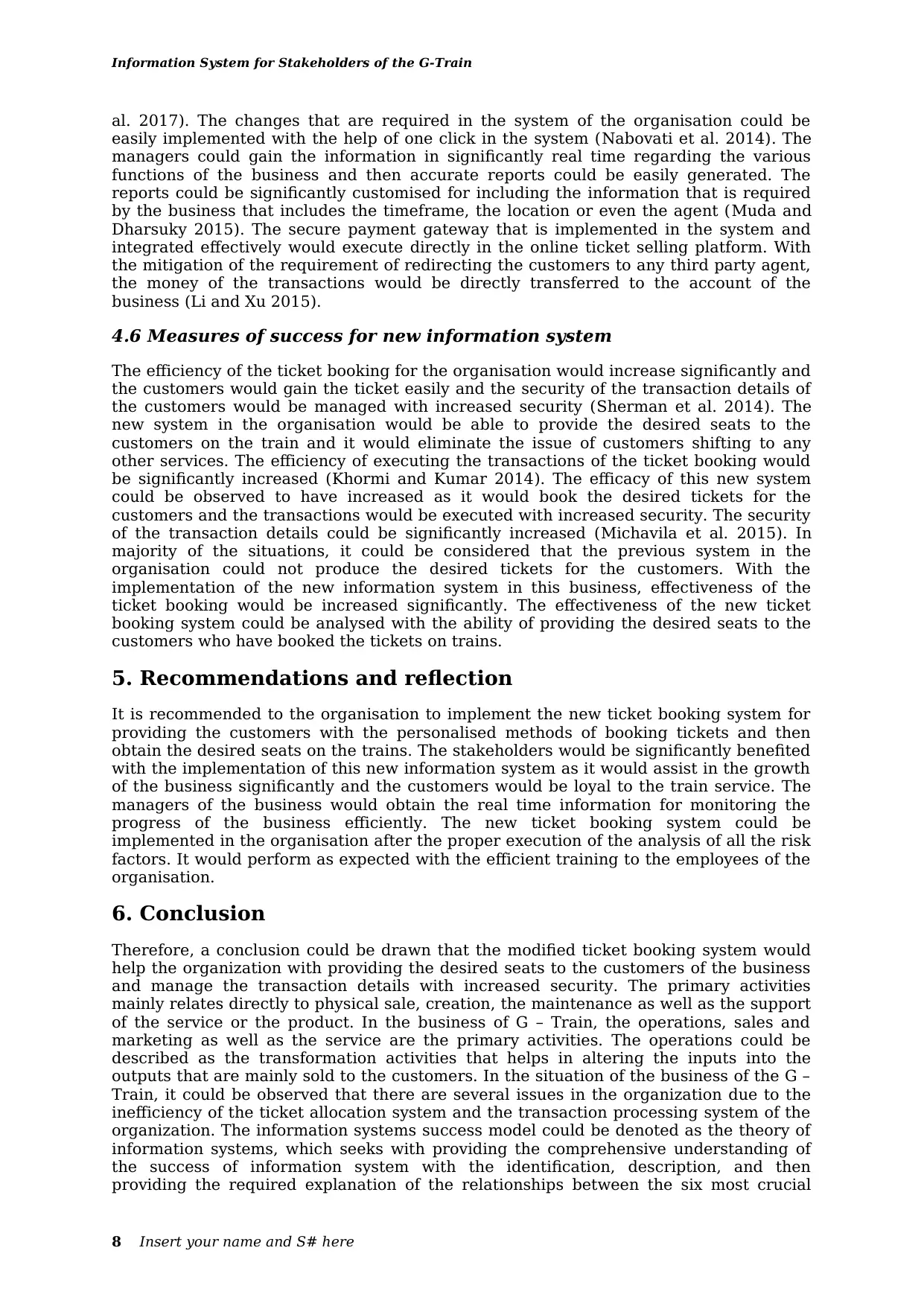
Information System for Stakeholders of the G-Train
al. 2017). The changes that are required in the system of the organisation could be
easily implemented with the help of one click in the system (Nabovati et al. 2014). The
managers could gain the information in significantly real time regarding the various
functions of the business and then accurate reports could be easily generated. The
reports could be significantly customised for including the information that is required
by the business that includes the timeframe, the location or even the agent (Muda and
Dharsuky 2015). The secure payment gateway that is implemented in the system and
integrated effectively would execute directly in the online ticket selling platform. With
the mitigation of the requirement of redirecting the customers to any third party agent,
the money of the transactions would be directly transferred to the account of the
business (Li and Xu 2015).
4.6 Measures of success for new information system
The efficiency of the ticket booking for the organisation would increase significantly and
the customers would gain the ticket easily and the security of the transaction details of
the customers would be managed with increased security (Sherman et al. 2014). The
new system in the organisation would be able to provide the desired seats to the
customers on the train and it would eliminate the issue of customers shifting to any
other services. The efficiency of executing the transactions of the ticket booking would
be significantly increased (Khormi and Kumar 2014). The efficacy of this new system
could be observed to have increased as it would book the desired tickets for the
customers and the transactions would be executed with increased security. The security
of the transaction details could be significantly increased (Michavila et al. 2015). In
majority of the situations, it could be considered that the previous system in the
organisation could not produce the desired tickets for the customers. With the
implementation of the new information system in this business, effectiveness of the
ticket booking would be increased significantly. The effectiveness of the new ticket
booking system could be analysed with the ability of providing the desired seats to the
customers who have booked the tickets on trains.
5. Recommendations and reflection
It is recommended to the organisation to implement the new ticket booking system for
providing the customers with the personalised methods of booking tickets and then
obtain the desired seats on the trains. The stakeholders would be significantly benefited
with the implementation of this new information system as it would assist in the growth
of the business significantly and the customers would be loyal to the train service. The
managers of the business would obtain the real time information for monitoring the
progress of the business efficiently. The new ticket booking system could be
implemented in the organisation after the proper execution of the analysis of all the risk
factors. It would perform as expected with the efficient training to the employees of the
organisation.
6. Conclusion
Therefore, a conclusion could be drawn that the modified ticket booking system would
help the organization with providing the desired seats to the customers of the business
and manage the transaction details with increased security. The primary activities
mainly relates directly to physical sale, creation, the maintenance as well as the support
of the service or the product. In the business of G – Train, the operations, sales and
marketing as well as the service are the primary activities. The operations could be
described as the transformation activities that helps in altering the inputs into the
outputs that are mainly sold to the customers. In the situation of the business of the G –
Train, it could be observed that there are several issues in the organization due to the
inefficiency of the ticket allocation system and the transaction processing system of the
organization. The information systems success model could be denoted as the theory of
information systems, which seeks with providing the comprehensive understanding of
the success of information system with the identification, description, and then
providing the required explanation of the relationships between the six most crucial
8 Insert your name and S# here
al. 2017). The changes that are required in the system of the organisation could be
easily implemented with the help of one click in the system (Nabovati et al. 2014). The
managers could gain the information in significantly real time regarding the various
functions of the business and then accurate reports could be easily generated. The
reports could be significantly customised for including the information that is required
by the business that includes the timeframe, the location or even the agent (Muda and
Dharsuky 2015). The secure payment gateway that is implemented in the system and
integrated effectively would execute directly in the online ticket selling platform. With
the mitigation of the requirement of redirecting the customers to any third party agent,
the money of the transactions would be directly transferred to the account of the
business (Li and Xu 2015).
4.6 Measures of success for new information system
The efficiency of the ticket booking for the organisation would increase significantly and
the customers would gain the ticket easily and the security of the transaction details of
the customers would be managed with increased security (Sherman et al. 2014). The
new system in the organisation would be able to provide the desired seats to the
customers on the train and it would eliminate the issue of customers shifting to any
other services. The efficiency of executing the transactions of the ticket booking would
be significantly increased (Khormi and Kumar 2014). The efficacy of this new system
could be observed to have increased as it would book the desired tickets for the
customers and the transactions would be executed with increased security. The security
of the transaction details could be significantly increased (Michavila et al. 2015). In
majority of the situations, it could be considered that the previous system in the
organisation could not produce the desired tickets for the customers. With the
implementation of the new information system in this business, effectiveness of the
ticket booking would be increased significantly. The effectiveness of the new ticket
booking system could be analysed with the ability of providing the desired seats to the
customers who have booked the tickets on trains.
5. Recommendations and reflection
It is recommended to the organisation to implement the new ticket booking system for
providing the customers with the personalised methods of booking tickets and then
obtain the desired seats on the trains. The stakeholders would be significantly benefited
with the implementation of this new information system as it would assist in the growth
of the business significantly and the customers would be loyal to the train service. The
managers of the business would obtain the real time information for monitoring the
progress of the business efficiently. The new ticket booking system could be
implemented in the organisation after the proper execution of the analysis of all the risk
factors. It would perform as expected with the efficient training to the employees of the
organisation.
6. Conclusion
Therefore, a conclusion could be drawn that the modified ticket booking system would
help the organization with providing the desired seats to the customers of the business
and manage the transaction details with increased security. The primary activities
mainly relates directly to physical sale, creation, the maintenance as well as the support
of the service or the product. In the business of G – Train, the operations, sales and
marketing as well as the service are the primary activities. The operations could be
described as the transformation activities that helps in altering the inputs into the
outputs that are mainly sold to the customers. In the situation of the business of the G –
Train, it could be observed that there are several issues in the organization due to the
inefficiency of the ticket allocation system and the transaction processing system of the
organization. The information systems success model could be denoted as the theory of
information systems, which seeks with providing the comprehensive understanding of
the success of information system with the identification, description, and then
providing the required explanation of the relationships between the six most crucial
8 Insert your name and S# here
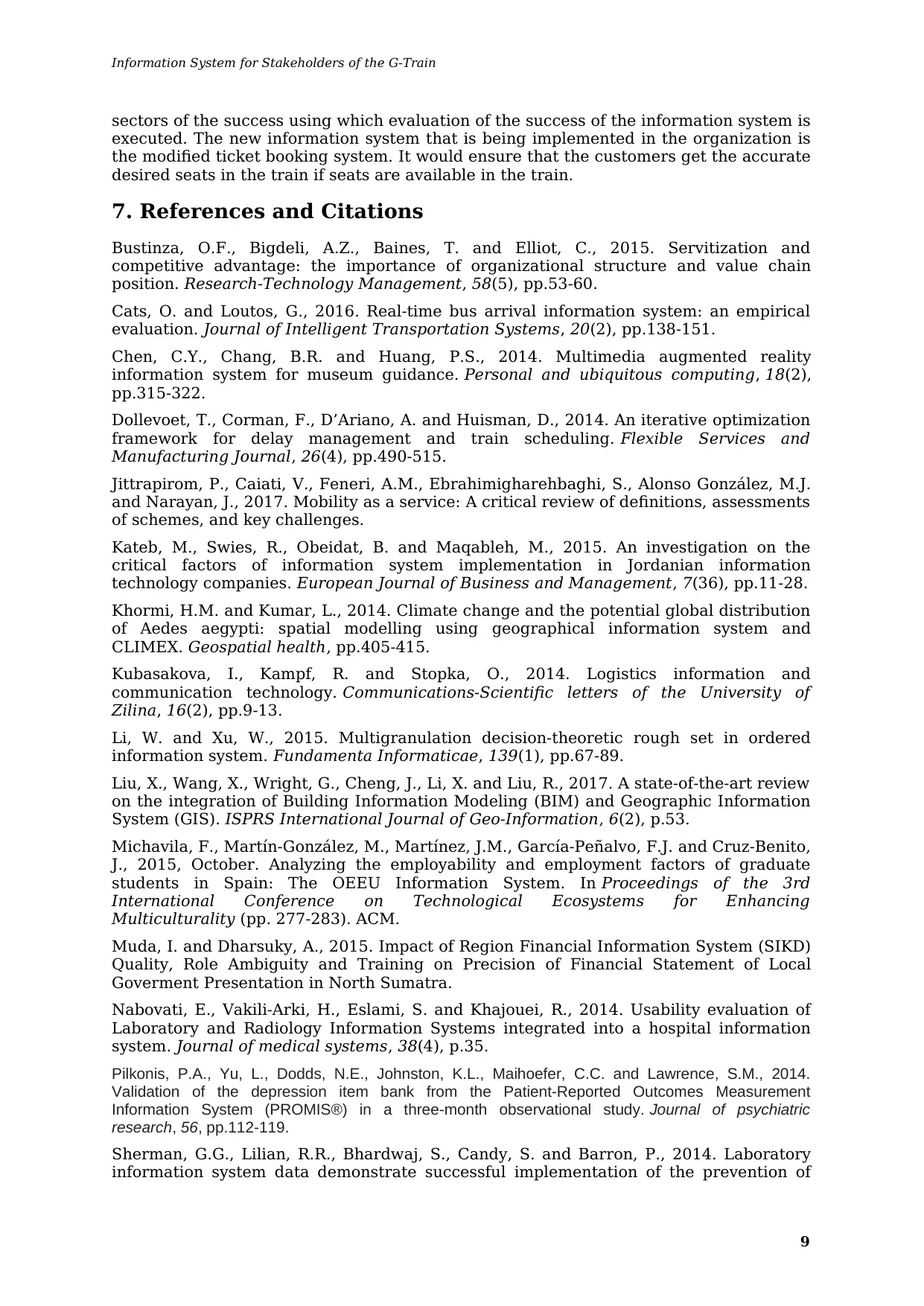
Information System for Stakeholders of the G-Train
sectors of the success using which evaluation of the success of the information system is
executed. The new information system that is being implemented in the organization is
the modified ticket booking system. It would ensure that the customers get the accurate
desired seats in the train if seats are available in the train.
7. References and Citations
Bustinza, O.F., Bigdeli, A.Z., Baines, T. and Elliot, C., 2015. Servitization and
competitive advantage: the importance of organizational structure and value chain
position. Research-Technology Management, 58(5), pp.53-60.
Cats, O. and Loutos, G., 2016. Real-time bus arrival information system: an empirical
evaluation. Journal of Intelligent Transportation Systems, 20(2), pp.138-151.
Chen, C.Y., Chang, B.R. and Huang, P.S., 2014. Multimedia augmented reality
information system for museum guidance. Personal and ubiquitous computing, 18(2),
pp.315-322.
Dollevoet, T., Corman, F., D’Ariano, A. and Huisman, D., 2014. An iterative optimization
framework for delay management and train scheduling. Flexible Services and
Manufacturing Journal, 26(4), pp.490-515.
Jittrapirom, P., Caiati, V., Feneri, A.M., Ebrahimigharehbaghi, S., Alonso González, M.J.
and Narayan, J., 2017. Mobility as a service: A critical review of definitions, assessments
of schemes, and key challenges.
Kateb, M., Swies, R., Obeidat, B. and Maqableh, M., 2015. An investigation on the
critical factors of information system implementation in Jordanian information
technology companies. European Journal of Business and Management, 7(36), pp.11-28.
Khormi, H.M. and Kumar, L., 2014. Climate change and the potential global distribution
of Aedes aegypti: spatial modelling using geographical information system and
CLIMEX. Geospatial health, pp.405-415.
Kubasakova, I., Kampf, R. and Stopka, O., 2014. Logistics information and
communication technology. Communications-Scientific letters of the University of
Zilina, 16(2), pp.9-13.
Li, W. and Xu, W., 2015. Multigranulation decision-theoretic rough set in ordered
information system. Fundamenta Informaticae, 139(1), pp.67-89.
Liu, X., Wang, X., Wright, G., Cheng, J., Li, X. and Liu, R., 2017. A state-of-the-art review
on the integration of Building Information Modeling (BIM) and Geographic Information
System (GIS). ISPRS International Journal of Geo-Information, 6(2), p.53.
Michavila, F., Martín-González, M., Martínez, J.M., García-Peñalvo, F.J. and Cruz-Benito,
J., 2015, October. Analyzing the employability and employment factors of graduate
students in Spain: The OEEU Information System. In Proceedings of the 3rd
International Conference on Technological Ecosystems for Enhancing
Multiculturality (pp. 277-283). ACM.
Muda, I. and Dharsuky, A., 2015. Impact of Region Financial Information System (SIKD)
Quality, Role Ambiguity and Training on Precision of Financial Statement of Local
Goverment Presentation in North Sumatra.
Nabovati, E., Vakili-Arki, H., Eslami, S. and Khajouei, R., 2014. Usability evaluation of
Laboratory and Radiology Information Systems integrated into a hospital information
system. Journal of medical systems, 38(4), p.35.
Pilkonis, P.A., Yu, L., Dodds, N.E., Johnston, K.L., Maihoefer, C.C. and Lawrence, S.M., 2014.
Validation of the depression item bank from the Patient-Reported Outcomes Measurement
Information System (PROMIS®) in a three-month observational study. Journal of psychiatric
research, 56, pp.112-119.
Sherman, G.G., Lilian, R.R., Bhardwaj, S., Candy, S. and Barron, P., 2014. Laboratory
information system data demonstrate successful implementation of the prevention of
9
sectors of the success using which evaluation of the success of the information system is
executed. The new information system that is being implemented in the organization is
the modified ticket booking system. It would ensure that the customers get the accurate
desired seats in the train if seats are available in the train.
7. References and Citations
Bustinza, O.F., Bigdeli, A.Z., Baines, T. and Elliot, C., 2015. Servitization and
competitive advantage: the importance of organizational structure and value chain
position. Research-Technology Management, 58(5), pp.53-60.
Cats, O. and Loutos, G., 2016. Real-time bus arrival information system: an empirical
evaluation. Journal of Intelligent Transportation Systems, 20(2), pp.138-151.
Chen, C.Y., Chang, B.R. and Huang, P.S., 2014. Multimedia augmented reality
information system for museum guidance. Personal and ubiquitous computing, 18(2),
pp.315-322.
Dollevoet, T., Corman, F., D’Ariano, A. and Huisman, D., 2014. An iterative optimization
framework for delay management and train scheduling. Flexible Services and
Manufacturing Journal, 26(4), pp.490-515.
Jittrapirom, P., Caiati, V., Feneri, A.M., Ebrahimigharehbaghi, S., Alonso González, M.J.
and Narayan, J., 2017. Mobility as a service: A critical review of definitions, assessments
of schemes, and key challenges.
Kateb, M., Swies, R., Obeidat, B. and Maqableh, M., 2015. An investigation on the
critical factors of information system implementation in Jordanian information
technology companies. European Journal of Business and Management, 7(36), pp.11-28.
Khormi, H.M. and Kumar, L., 2014. Climate change and the potential global distribution
of Aedes aegypti: spatial modelling using geographical information system and
CLIMEX. Geospatial health, pp.405-415.
Kubasakova, I., Kampf, R. and Stopka, O., 2014. Logistics information and
communication technology. Communications-Scientific letters of the University of
Zilina, 16(2), pp.9-13.
Li, W. and Xu, W., 2015. Multigranulation decision-theoretic rough set in ordered
information system. Fundamenta Informaticae, 139(1), pp.67-89.
Liu, X., Wang, X., Wright, G., Cheng, J., Li, X. and Liu, R., 2017. A state-of-the-art review
on the integration of Building Information Modeling (BIM) and Geographic Information
System (GIS). ISPRS International Journal of Geo-Information, 6(2), p.53.
Michavila, F., Martín-González, M., Martínez, J.M., García-Peñalvo, F.J. and Cruz-Benito,
J., 2015, October. Analyzing the employability and employment factors of graduate
students in Spain: The OEEU Information System. In Proceedings of the 3rd
International Conference on Technological Ecosystems for Enhancing
Multiculturality (pp. 277-283). ACM.
Muda, I. and Dharsuky, A., 2015. Impact of Region Financial Information System (SIKD)
Quality, Role Ambiguity and Training on Precision of Financial Statement of Local
Goverment Presentation in North Sumatra.
Nabovati, E., Vakili-Arki, H., Eslami, S. and Khajouei, R., 2014. Usability evaluation of
Laboratory and Radiology Information Systems integrated into a hospital information
system. Journal of medical systems, 38(4), p.35.
Pilkonis, P.A., Yu, L., Dodds, N.E., Johnston, K.L., Maihoefer, C.C. and Lawrence, S.M., 2014.
Validation of the depression item bank from the Patient-Reported Outcomes Measurement
Information System (PROMIS®) in a three-month observational study. Journal of psychiatric
research, 56, pp.112-119.
Sherman, G.G., Lilian, R.R., Bhardwaj, S., Candy, S. and Barron, P., 2014. Laboratory
information system data demonstrate successful implementation of the prevention of
9
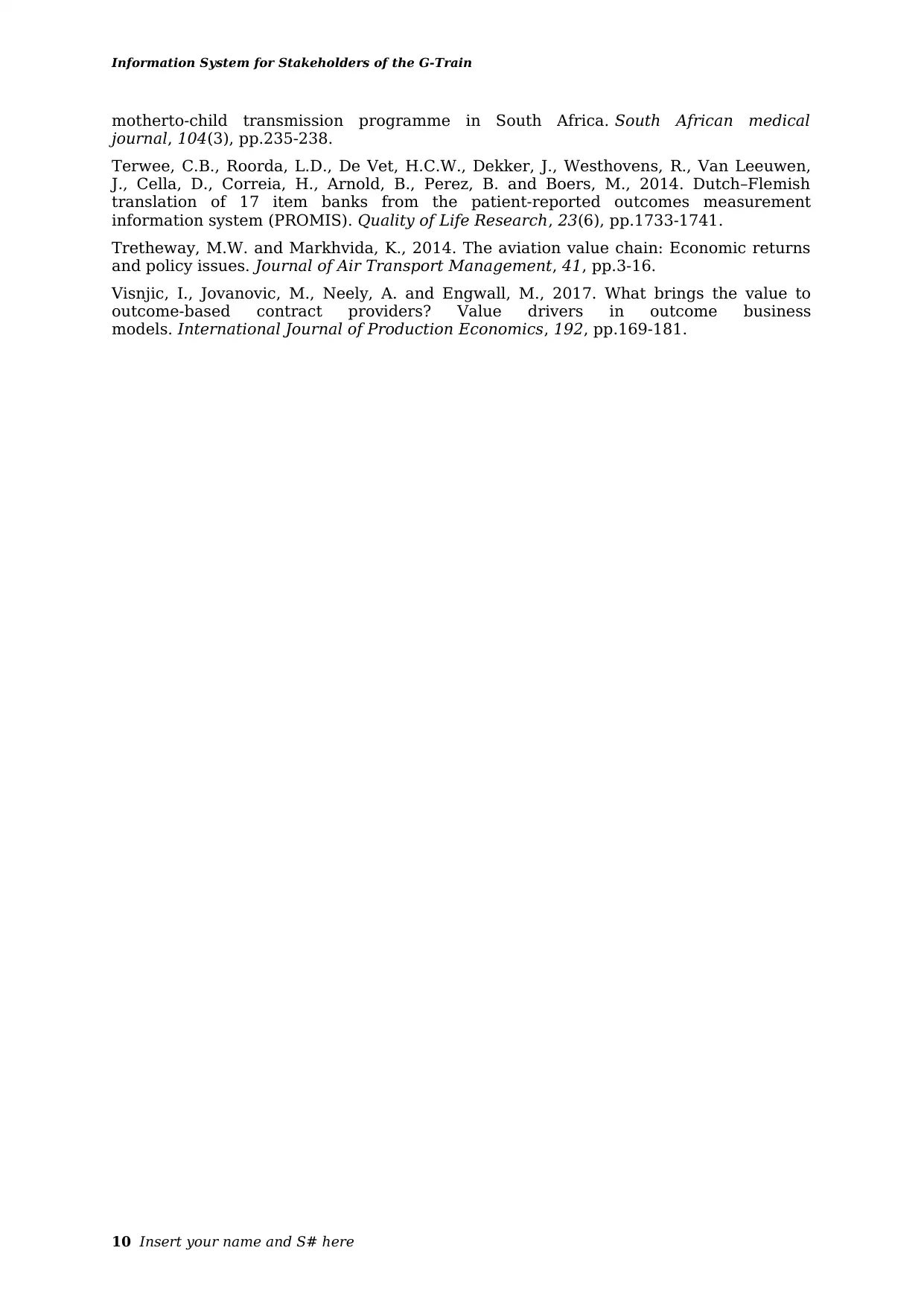
Information System for Stakeholders of the G-Train
motherto-child transmission programme in South Africa. South African medical
journal, 104(3), pp.235-238.
Terwee, C.B., Roorda, L.D., De Vet, H.C.W., Dekker, J., Westhovens, R., Van Leeuwen,
J., Cella, D., Correia, H., Arnold, B., Perez, B. and Boers, M., 2014. Dutch–Flemish
translation of 17 item banks from the patient-reported outcomes measurement
information system (PROMIS). Quality of Life Research, 23(6), pp.1733-1741.
Tretheway, M.W. and Markhvida, K., 2014. The aviation value chain: Economic returns
and policy issues. Journal of Air Transport Management, 41, pp.3-16.
Visnjic, I., Jovanovic, M., Neely, A. and Engwall, M., 2017. What brings the value to
outcome-based contract providers? Value drivers in outcome business
models. International Journal of Production Economics, 192, pp.169-181.
10 Insert your name and S# here
motherto-child transmission programme in South Africa. South African medical
journal, 104(3), pp.235-238.
Terwee, C.B., Roorda, L.D., De Vet, H.C.W., Dekker, J., Westhovens, R., Van Leeuwen,
J., Cella, D., Correia, H., Arnold, B., Perez, B. and Boers, M., 2014. Dutch–Flemish
translation of 17 item banks from the patient-reported outcomes measurement
information system (PROMIS). Quality of Life Research, 23(6), pp.1733-1741.
Tretheway, M.W. and Markhvida, K., 2014. The aviation value chain: Economic returns
and policy issues. Journal of Air Transport Management, 41, pp.3-16.
Visnjic, I., Jovanovic, M., Neely, A. and Engwall, M., 2017. What brings the value to
outcome-based contract providers? Value drivers in outcome business
models. International Journal of Production Economics, 192, pp.169-181.
10 Insert your name and S# here
1 out of 10
Related Documents
Your All-in-One AI-Powered Toolkit for Academic Success.
+13062052269
info@desklib.com
Available 24*7 on WhatsApp / Email
![[object Object]](/_next/static/media/star-bottom.7253800d.svg)
Unlock your academic potential
© 2024 | Zucol Services PVT LTD | All rights reserved.





